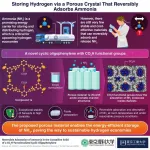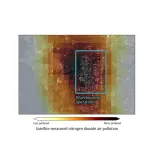(Press-News.org) (WASHINGTON, July 24, 2024) – In patients with diffuse large B-cell non-Hodgkin lymphoma (DLBCL), the two hallmark post-chimeric antigen receptor (CAR)-T therapy toxicities are extremely rare after two weeks, supporting a shorter, more flexible toxicity monitoring period, according to a study published in Blood Advances.
Currently, three CAR T-cell therapies — axicabtagene ciloleucel (axi-cel), tisagenlecleucel (tisa-cel), and lisocabtagene maraleucel (liso-cel) — are approved for treating DLBCL, a cancer that affects the white blood cells responsible for producing antibodies. However, patients receiving these therapies are at high risk of developing either cytokine release syndrome (CRS) or immune effector cell-associated neurotoxicity syndrome (ICANS). CRS is characterized by fever, as well as low blood pressure and/or oxygen levels in more severe cases. ICANS may cause temporary effects such as altered mental status and confusion, or even loss of consciousness and/or seizures in more severe cases. Both toxicities can also result in rapid decline and death.
To monitor and manage these toxicities, the U.S. Food and Drug Administration (FDA) established a Risk Evaluation and Mitigation Strategy (REMS) mandating that recipients of CAR-T therapy remain within a two-hour distance of their authorized treatment center (ATC) for four weeks after therapy and refrain from driving for eight weeks post-treatment. Most ATCs have even stricter criteria than those directed by the REMS, requiring patients to stay within a 30- to 60-minute radius of their ATC and have a dedicated caregiver. In a recent study of 185 patients receiving CAR-T therapy, 65% lived more than 30 minutes away from the closest ATC.
“As a clinician that administers CAR-T, I’ve had many patients who have not been able to receive it because of barriers to access,” said study author Nausheen Ahmed, MD, associate professor of hematologic malignancies and cellular therapeutics, assistant director of cellular therapeutics, and medical director of the BMT Survivorship Program at the University of Kansas Medical Center. “I have patients who are traveling for six or even eight hours to get treatment.”
In a retrospective study across nine treatment centers, Dr. Ahmed and her colleagues investigated the onset and duration of CRS, ICANS, and other non-relapse causes of death post-CAR-T therapy to determine if the monitoring period and driving restriction might be shortened to increase treatment accessibility. The first-of-its-kind study investigated 475 patients who underwent infusion therapy between March 2018 and May 2023. Of the 475 patients evaluated, 216 (45%) received axi-cel, 158 (33%) received tisa-cel, and 101 (21%) received liso-cel. Most of the study participants (69.8%) received CAR-T as third-line or later therapy.
Across all patients, the incidence of any grade of CRS was 60%, while the incidence of any grade of ICANS was 32.4%. In the first seven days after CAR-T infusion, new-onset CRS occurred in 57.5% of patients and new-onset ICANS occurred in 25.4%. During the eight- to 12-day period following treatment, 5.4% of patients experienced new-onset CRS and 9.3% experienced new-onset ICANS. After 12 days post-infusion, there were no recorded cases of new-onset CRS and only one case of new-onset ICANS reported in a tisa-cel recipient.
The study showed that most patients who developed CRS or ICANS did so within the first two weeks following infusion. After this period, no new-onset CRS cases were reported and only 0.7% of patients exhibited new-onset ICANS. According to the researchers, these results support downgrading from the standard four-week monitoring period to a two-week one (with the option to extend, dependent on patient status), as well as instituting a shorter driving restriction.
Results also showed that after two weeks, infections, which developed in 14.5% of patients within the 28 days post-infusion, were the most common cause of death. Two infection-related deaths occurred in the first 28 days following CAR-T infusion, while five such deaths were reported between days 29 and 90. Bacterial infections were most common during the period closely following CAR-T infusion, while viral infections were most prevalent after four weeks post-infusion.
“We are learning that infection may be driving a lot of the non-relapse mortality and toxicity within the first few months after CAR-T infusion, so we have to shift our focus to preventing and managing infections after those two weeks,” Dr. Ahmed said. To do this, she suggested a hybrid model of care, which would also shorten the restriction periods for patients. “Instead of the ATC trying to keep the patient locally for a long time, we could collaborate with and train community hematologists/oncologists and referring physicians to identify, initiate treatment for, and collaborate with the ATC to manage infections and other less common side effects.”
Shortening restriction periods can help mitigate the challenges associated with CAR-T therapy for both patients and their families, as well as prevent patients from having to resort to more accessible therapies when CAR-T could be curative, Dr. Ahmed said. This could make an especially big difference in the lives of patients from minority backgrounds and of lower socioeconomic status, who are disproportionately affected by barriers to access, she added. Studies have shown that 25% to 60% of patients eligible for CAR-T therapy must relocate during the required REMS monitoring period, depending on their ATC’s requirements. Further, treatment-adjacent expenses are not always covered by insurance or the ATC.
There were a few limitations to the study. Each ATC had individual guidelines that influenced patient eligibility and management of CRS and ICANS, and some variables were unable to be captured, including late-onset neutropenia and hypogammaglobulinemia, patient-reported outcomes, and caregiver education practices. Additionally, the study was limited to patients with DLBCL and the therapies tested.
The researchers have published similar results in a study of the CAR-T therapies idecabtagene vicleucel and ciltacabtagene autoleucel for the treatment of multiple myeloma.
# # #
Blood Advances (bloodadvances.org) is an online, open-access journal publishing more peer-reviewed hematology research than any other academic journal worldwide. Blood Advances is part of the Blood journals portfolio (bloodjournals.org) from the American Society of Hematology (ASH) (hematology.org).
Claire Whetzel, 202-629-5085
cwhetzel@hematology.org
END
FDA-mandated CAR-T monitoring period could be halved
CAR-T toxicities are rare after two weeks in diffuse large B-cell non-Hodgkin lymphoma treatment, and shorter restriction periods could increase overall treatment accessibility
2024-07-24
ELSE PRESS RELEASES FROM THIS DATE:
How spaceborne satellites can help with forest monitoring
2024-07-24
Information like forest canopy height can be useful in assessing the health of a forest, but current measuring methods are not always feasible for large geographic regions or adaptable to diverse forest types. Monitoring from space can be a solution.
Forests function as more than a place for a quiet retreat: trees intake and absorb carbon dioxide (a major greenhouse gas), a process also known as carbon sequestration, and are essential parts of water regulation, habitat provision, and support much of the world’s terrestrial biodiversity. Quantifying forest structure parameters, ...
A single-molecule-based organic porous material with great potential for efficient ammonia storage
2024-07-24
All around the world, scientists are striving towards next-generation energy technologies that can help us move away from fossil fuels. Using hydrogen as an energy carrier and clean energy source is perhaps one of the most promising solutions on the horizon. However, there is a major challenge to overcome before hydrogen economies become a reality: hydrogen gas is remarkably difficult to store and transport safely, which severely limits its applicability across many fields.
Against this backdrop, a research team from Tokyo Institute of Technology, Japan, and Tokyo University of Science, Japan has been working hard to reach an alternative solution to the hydrogen storage problem. Led by Associate ...
Physical activity improves early with customized text messages in patients with heart problems
2024-07-24
Exercise is one of the best ways to reduce your risk of heart disease or having a second cardiovascular event, such as a heart attack or stroke.
As more people use wearable technology, such as smartwatches, health care researchers continue to explore whether it can successfully promote physical activity.
That includes customized messages designed to encourage individual patients to be more active in their current location, like walking outside when the weather is nice.
In such a study led by the University of Michigan ...
Sharing brain images can foster new neuroscience discoveries
2024-07-24
DALLAS, July 24, 2024 — In this era of machine learning and artificial intelligence, harnessing large-scale neuroimaging can facilitate new discoveries in neuroscience research.[1]
To that end, the American Heart Association, celebrating 100 years of lifesaving service in 2024, has awarded a two-year, $460,000 grant to a consortium of three academic medical centers to work collaboratively and share de-identified imaging data from individuals enrolled in its Get With The Guidelines® – Stroke registry.
A team at Yale University will ...
Guideline on management of central airway obstruction released by CHEST
2024-07-24
Glenview, Illinois – The American College of Chest Physicians® (CHEST) recently released a new clinical guideline on central airway obstruction (CAO). Published in the journal CHEST®, the guideline contains 12 evidence-based recommendations to guide the management of both malignant and nonmalignant CAO.
“Central airway obstruction is associated with a poor prognosis, and the management of CAO is highly variable dependent on the provider expertise and local resources. By releasing this guideline, the panel hopes to standardize the definition ...
Same-sex marriage recognition helps countries attract, retain highly skilled workers
2024-07-24
PULLMAN, Wash. – Marriage equality appears to have a major economic benefit for countries. Washington State University researchers found that European countries that recognized same-sex marriages kept more of their highly skilled workers from emigrating to the U.S.
The researchers analyzed 20 years of data on HB1 visas, which are reserved for immigrants to the U.S. with advanced degrees and specialized skills. From 2000-2019, a total of 13 European Union countries legalized same-sex marriage—and ...
Mixed approach to reforestation better than planting or regeneration alone
2024-07-24
DURHAM, NC – Reforestation in low- and middle-income countries can remove up to 10 times more carbon dioxide from the atmosphere at lower cost than previously estimated, making this a potentially more important option to fight climate change, according to a study in Nature Climate Change.
Reforestation regrows trees on degraded lands where human activities removed original forests. Most current reforestation programs focus on tree planting alone, but the study estimates that nearly half of all suitable reforestation locations would be more effective at sequestering carbon if forests were allowed to grow back ...
Warehousing industry increases health-harming pollutants
2024-07-24
WASHINGTON (July 24, 2024)--America's demand for products delivered to the doorstep has led to a dramatic increase in e-commerce and the warehousing industry.
A first-of-a-kind study now shows that people living in communities located next to these large warehouses are exposed to 20% more of a traffic-related air pollutant that can lead to asthma and other life-threatening health conditions.
“Increased truck traffic to and from these recently built large warehouses means people living downwind are inhaling an increased amount of harmful nitrogen dioxide pollution,” said Gaige Kerr, lead author of the study and an assistant research ...
Variants in the genome affect DNA methylation
2024-07-24
A new study by scientists at deCODE Genetics, a subsidiary of Amgen, shows that sequence variants drive the correlation between DNA methylation and gene expression. The same variants are linked to various diseases and other human traits.
The research was published today in the scientific journal Nature Genetics under the title: The correlation between CpG methylation and gene expression is driven by sequence variants.
Nanopore sequencing is a new technology developed by ONT (Oxford Nanopore Technology), that enables us to ...
How well does tree planting work in climate change fight? It depends, OSU research shows
2024-07-24
CORVALLIS, Ore. – Using trees as a cost-effective tool against climate change is more complicated than simply planting large numbers of them, an international collaboration that includes an Oregon State University scientist has shown.
Jacob Bukoski of the OSU College of Forestry and seven other researchers synthesized data from thousands of reforestation sites in 130 countries and found that roughly half the time it’s better just to let nature take its course.
Findings of the study led by Conservation International were published today in Nature ...
LAST 30 PRESS RELEASES:
Decoupling the HOR enhancement on PtRu: Dynamically matching interfacial water to reaction coordinates
Sulfur isn’t poisonous when it synergistically acts with phosphine in olefins hydroformylation
URI researchers uncover molecular mechanisms behind speciation in corals
Chitin based carbon aerogel offers a cleaner way to store thermal energy
Tracing hidden sources of nitrate pollution in rapidly changing rural urban landscapes
Viruses on plastic pollution may quietly accelerate the spread of antibiotic resistance
Three UH Rainbow Babies & Children’s faculty elected to prestigious American Pediatric Society
Tunnel resilience models unveiled to aid post-earthquake recovery
Satellite communication systems: the future of 5G/6G connectivity
Space computing power networks: a new frontier for satellite technologies
Experiments advance potential of protein that makes hydrogen sulfide as a therapeutic target for Alzheimer’s disease
Examining private equity’s role in fertility care
Current Molecular Pharmacology achieves a landmark: real-time CiteScore advances to 7.2
Skeletal muscle epigenetic clocks developed using postmortem tissue from an Asian population
Estimating unemployment rates with social media data
Climate policies can backfire by eroding “green” values, study finds
Too much screen time too soon? A*STAR study links infant screen exposure to brain changes and teen anxiety
Global psychiatry mourns Professor Dan Stein, visionary who transformed mental health science across Africa and beyond
KIST develops eco-friendly palladium recovery technology to safeguard resource security
Statins significantly reduce mortality risk for adults with diabetes, regardless of cardiovascular risk
Brain immune cells may drive more damage in females than males with Alzheimer’s
Evidence-based recommendations empower clinicians to manage epilepsy in pregnancy
Fungus turns bark beetles’ defenses against them
There are new antivirals being tested for herpesviruses. Scientists now know how they work
CDI scientist, colleagues author review of global burden of fungus Candida auris
How does stroke influence speech comprehension?
B cells transiently unlock their plasticity, risking lymphoma development
Advanced AI dodel predicts spoken language outcomes in deaf children after cochlear implants
Multimodal imaging-based cerebral blood flow prediction model development in simulated microgravity
Accelerated streaming subgraph matching framework is faster, more robust, and scalable
[Press-News.org] FDA-mandated CAR-T monitoring period could be halvedCAR-T toxicities are rare after two weeks in diffuse large B-cell non-Hodgkin lymphoma treatment, and shorter restriction periods could increase overall treatment accessibility





